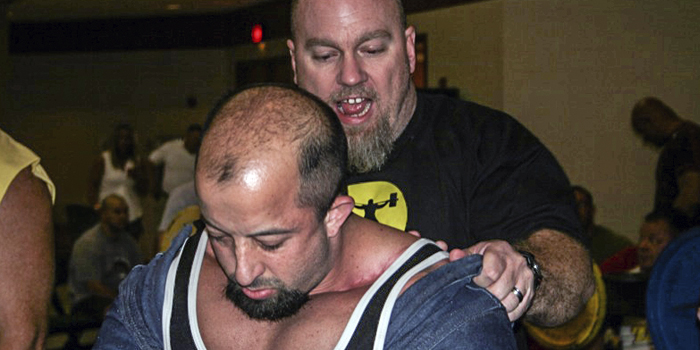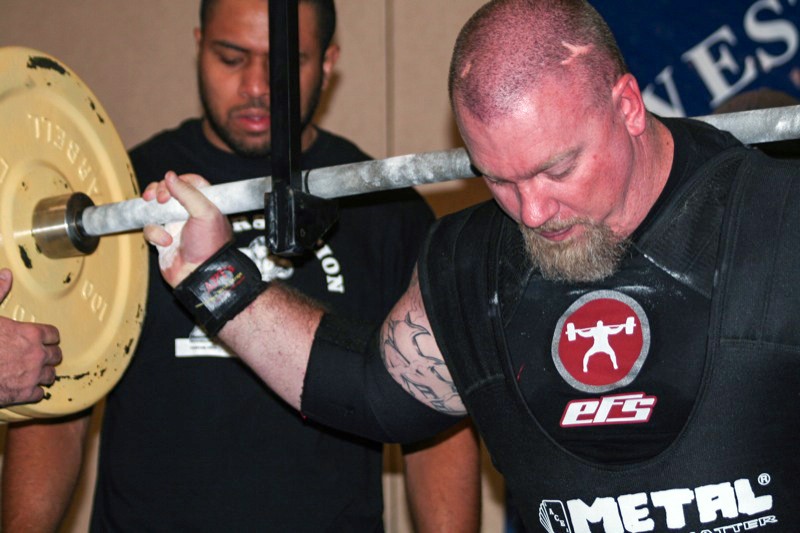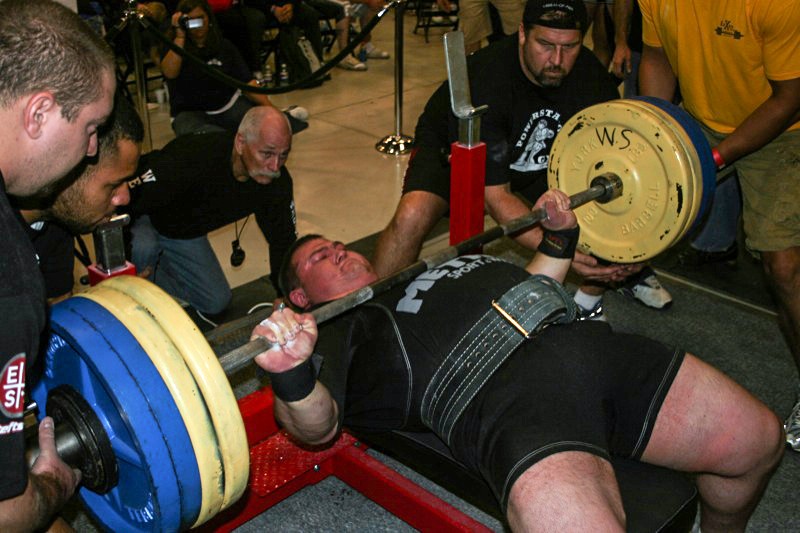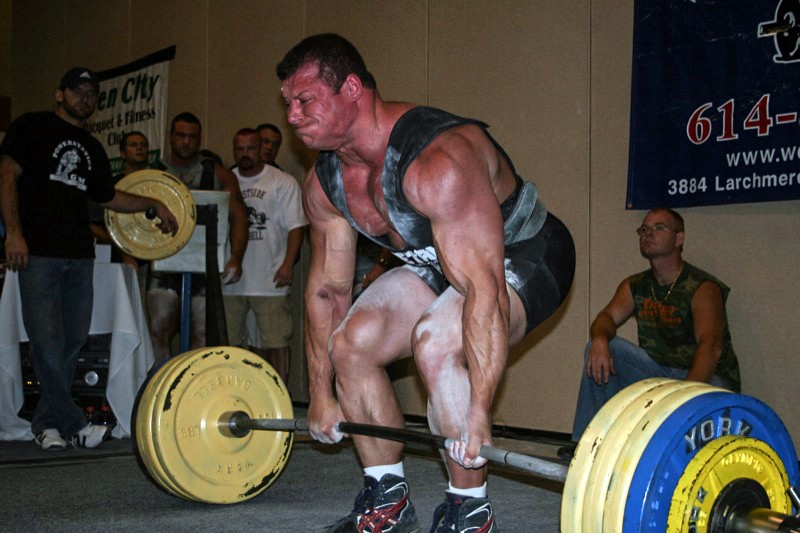
So you’ve signed up for your first powerlifting meet and you’re amped up and ready to go. At the same time, you probably have a dozen questions. Nerves are high and you are scrambling to try to understand everything so that come competition day, you are ready. While this article won’t be an end all, be all to give you every last answer to prepare you for your first meet, I do want to prepare you in avoiding the biggest rookie mistakes.
RECENT: Case Study: Programming Considerations for the Injury-Prone Powerlifter
At every meet, these mistakes are being made, and they stick out like sore thumbs and separate those who are prepared from those who are unprepared. So without drawing this out any further, let’s dive in, separating these into two categories: pre-meet training mistakes and competition day mistakes.
The Three Biggest Pre-Meet Training and Programming Mistakes
1. Not Pausing Your Bench Press in Training
All three of these mistakes are going to deal with training specificity, or training in a manner that would mimic those of competition. And probably the most prevalent one you will find is people not pausing their bench press in training. If you didn’t know already—and we will cover this further in the competition day mistakes section—you will be pausing your bench press on competition day. If this is not something you are used to and you have been training touch-and-go bench press all through your training leading up to meet day, you are going to be in for a surprise when all of the sudden you can’t complete that bench PR that you thought for sure you were going to hit. Touch-and-go bench press relies greatly on the stretch reflex, and when you switch to a paused competition style bench press, that strength benefit from the stretch reflex dissipates. At the same time, though, if you consistently train with a paused bench you may actually find that it catches up to your touch-and-go bench press strength, due to improved bracing and movement mechanics. The day to experiment with this is not the day of the competition; it's during all the training leading up to it. Short and simple, train the bench press with a pause.
2. Not Squatting to Competition Depth in Training
The next big training mistake is not squatting to depth in training leading up to the meet. People will argue that come meet day it will be there, and that the extra weight will squeeze them down the extra inch or so they need, but that’s a dangerous game to play. In most popular federations, depth is going to mean that the top level of your hip crease is below the top level of your knee. Just like pausing your bench press in training, make sure to train at depth with your squats. That extra one to two inches could change your strength capabilities, and more importantly the movement pattern you are used to. So if all of the sudden on meet day you have to change the pattern and depth of your squat, one of two things probably will happen:
- You will not hit depth and will receive a no lift.
- You will achieve depth, but the weights you thought would feel easy seem very heavy.
Short and simple, train to depth on the squat in training.
3. Using a Different Bar for Deadlifting in Training Than You Will Use at the Meet
The final big training mistake people make is training with a different bar on deadlifts than they will use at the meet. If you are competing in the USAPL, you will be using a stiff bar, most likely an Ohio Power Bar (or if you are lucky, an Eleiko Power Bar). If you are competing in any other federation, you will be using a deadlift bar. If you aren’t familiar with a deadlift bar, it is longer than a normal bar and has a lot more flex, allowing most people to be able to deadlift more weight than they typically can on a stiff bar. More important, though, is knowing that it is a different movement.
When using a deadlift bar, due to the flex, you are most likely starting the pull position from an inch or two higher than you would with a stiff bar, which results in a slight decrease in the range of motion. If you are competing in the USAPL and have been using a deadlift bar until competition, it will feel like a new movement when you reach down and try to deadlift with a stiff bar. That extra one to two inches of range of motion will now feel like an extra foot when the pressure is on for competition day. For other federations where you will use a deadlift bar, it may be slightly less detrimental, but training with a stiff bar throughout your training will have a small negative effect as well. Learning how to pull the slack out of a deadlift bar is a skill, and if the first time you are ever touching one is competition day, the typical result is an increased “jerk” motion off the floor and an increased rounding of the back due to not gaining the proper tightness before initiating the lift. Again, short and simple, train with the bar you will be using in competition, especially if you will be competing in the USAPL.
The Four Biggest Competition Day Mistakes
1. Cutting Weight to Make a Certain Weight Class
I hear it over and over: someone who has never competed is already looking at state records and seeing which ones they could possibly set and which weight class they need to be in to get those. (I did this, too. We all did if we are being honest.) Or they are looking at previous meets to see what people lifted and how competitive they would be in each weight class. That is all fine and dandy. In an accredited federation, state records are something to be proud of. But the fact is, in the USAPL or USPA, there is a good chance you aren’t going to be setting state records in your first meet, as the bar has been set pretty high. Maybe you want to compete in a certain weight class because you think you have a better chance at winning, which is understandable as well — we all want to win. But to be a bit blunt, for a meet I will be hosting in March with 60 lifters, I will be ordering 52 medals. The majority of the weight class and divisions will only have one or two people lifting in them, and this is how most local meets are. Experienced lifters will be fairly unanimous in saying that you will have a much better day all around if you come in as strong as possible rather than trying to cut down to a weight class so that you can place first in a class where you are the only lifter. A weight cut is going to most likely be correlated with a strength decrease, and in your first meet where nerves are high and anxiety is rampant, you will want to be your strongest. I promise you will have more fun going nine-for-nine, hitting PRs on all your lifts, and getting second place than if you go six-for-nine, miss all your third attempts because your strength just wasn’t where you thought it would be, and get first place in a lower weight class when you were the only lifter.
2. Not Knowing the Commands on Bench Press, Squat, and Deadlift
During competition, the head referee will be in charge of giving you commands on all three lifts. What are those commands and the biggest mistakes people make with them? Below I will cover each one, as well as include a link for a video from Barbell Brigade that gives some great information on the commands for each lift.
Bench Press Commands
Once you unrack the weight, which you can do a self unrack or have a handoff, you will be given the start command. All of these commands will be verbal and include a hand signal. Once given the start command you can begin the descent. When the bar reaches your chest, you must allow the bar to come to a complete stop. Once it does, the referee will give you the press command, at which point you can initiate the press and start the ascent. Once you have fully locked out the weight, you must wait until the judge gives you the rack command, when you can rack the bar and complete the lift.
The Mistakes
As already mentioned, many people will come into meet day having never trained a paused bench press and will be in for a surprise. The fact is that you probably will still be able to get a good lift, just maybe not as much weight as you thought you could do. Where the rookie mistakes happen are the start and rack commands. If you have never competed before, you’ve probably never waited for someone to tell you when you can actually start the bench press. You also will be really amped up that day and will be eager and anxious to get started. But make sure to wait! Wait for the start command, because even if you complete the lift successfully, if you start early it will be a no lift. Just as prevalent as jumping the start command will be racking the weight too early. You will get so excited about hitting this new bench press PR that your first extinct is to rack it, jump up, and go crazy, to the crushing disappointment that you racked the weight before the command and it was called a no lift. So once you complete the lift, make sure to wait for the rack command before returning the bar to the rack.
Squat Commands
For squat, you will be given only two commands: start and rack. You will unrack the bar, get your feet set, and find everything positioned. During that time, make sure to remain looking down, which is the natural tendency anyways. Once you are set, look up. At that point, the head referee will give you the verbal start command, along with the visual hand signal. Your next movement must be starting the lift — no more moving your feet or readjusting the bar. You will then complete a full squat. Make sure to understand that there is no “up” command. If you have a training partner that would like to give you that command to let you know when you hit depth and should initiate the ascent, you can do so, but that is not the job of the referee. Once the squat is completed, the referee will give you the rack command where you can then return the bar to the squat rack, completing the lift.
The Mistakes
The mistakes here are very similar to those of the bench press, where people will start the squat before the command or rack the bar too early. In my experience, by far the more prevalent of the two will be racking the squat before the command. In the squat, you can see the head referee, so it is a bit easier to remember the start command when you cannot only hear the command but also see the visual hand signal. However, with the rack command, just like the bench press, lifters get excited and rack too early. Wait! You’ve got plenty of time to be excited about your new PR; you just have to wait for that rack command to start the celebration.
Deadlift Commands
For deadlift, there is only one command, and that is down. You will start the lift at your own discretion, and once locked out and control is shown in that position, the head referee will give you the down command, completing the lift.
The Mistakes
There are significantly fewer people that mess up the deadlift commands than the bench press and the squat, but it still happens. It goes back to the same advice as before: wait! You will be able to see and hear this command with the head referee right in front of you, so make sure to hold that lockout and until they give you the down command.
3. Having the Wrong Underwear (Yes, I Am Serious)
It sounds silly, but at every single meet it happens, because there are in fact rules on what underwear you can wear. Underwear must be made of non-supportive material (cotton, nylon, or polyester) and must not have “legs”. So in short, guys will need whitey tighties, no boxers, boxer briefs, or compression shorts. For the women, this probably isn’t as much of an issue, as most female underwear fits this requirement, but the one no-go is boy shorts. And yes, underwear must be worn underneath your singlet. Commando is against the rules as well.
4. Setting Your Openers Too Heavy
We all want to hit PRs come meet day, but your first attempt is not the time to do that. If you didn’t already know, if you miss all three attempts on any one of your lifts, you bomb out of the meet, meaning you are done. The opening attempts are also the only weights you actually select before the meet starts. The other attempts you choose after hitting your opener or second attempt. While you get three attempts on all three lifts, those should not be three attempts at a PR. Those are three attempts to build the best overall total possible. I could write a whole separate article on my beliefs on proper attempt selection, which from coach to coach may differ, but what is a fairly universal belief is that the first attempt should be something you could hit even on your worst day.
If this is your first meet, by far the most nervous and anxious you will be is going into that first squat attempt. Those nerves and anxiety could throw you off, so the goal is just to hit a weight you know you can do, and each attempt after build upon that. My general rule of thumb is that the first attempt should be a weight you could probably do for three to four reps, or about 90% to 92% of your one-rep max. This first attempt will also give you an idea of how your strength is for the day and what your next attempts should be. It also is an attempt where many will make sure to leave zero doubt of a good lift. Not only do you have to lift the weight, you have to follow the commands mentioned earlier. So if you pick a weight that is a bit too heavy, you not only risk failing due to not being able to lift it, but you also risk getting red lights due to not hitting depth on squats, your butt popping up on the bench press, or hitching on the deadlift.
There are other mistakes as well, but from my experience, these seven are definitely the most prevalent. Hopefully, if you are a first-time competitor you read this article in detail, because I can guarantee it will save you from disappoint and regret, and make for a better overall experience at your first meet. The most important thing is to have fun, though. This sport is about getting as strong as possible and having fun doing it, so if either of those factors are missing on meet day, you are doing it wrong!
Steve DeNovi is a personal trainer, powerlifter, and strength coach from Springfield, Missouri specializing in strength athletics and post-physical therapy rehabilitation through his company Progressive Resistance Systems. For further questions, you can contact him at sdenovi@gmail.com and visit his website prsontheplatform.com.













